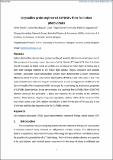Files in this item
Crystalline grain engineered CsPbIBr2 films for indoor photovoltaics
Item metadata
| dc.contributor.author | Ghosh, Paheli | |
| dc.contributor.author | Bruckbauer, Jochen | |
| dc.contributor.author | Trager-Cowan, Carol | |
| dc.contributor.author | Krishnan Jagadamma, Lethy | |
| dc.date.accessioned | 2023-02-25T00:42:08Z | |
| dc.date.available | 2023-02-25T00:42:08Z | |
| dc.date.issued | 2022-08-01 | |
| dc.identifier | 279188131 | |
| dc.identifier | b36e400b-6a51-4cde-a0bd-0431a09dd0a6 | |
| dc.identifier | 85127753377 | |
| dc.identifier | 000793253300003 | |
| dc.identifier.citation | Ghosh , P , Bruckbauer , J , Trager-Cowan , C & Krishnan Jagadamma , L 2022 , ' Crystalline grain engineered CsPbIBr 2 films for indoor photovoltaics ' , Applied Surface Science , vol. 592 , 152865 . https://doi.org/10.1016/j.apsusc.2022.152865 | en |
| dc.identifier.issn | 0169-4332 | |
| dc.identifier.other | RIS: urn:1B93054C917783247CF15349FFA6BF4E | |
| dc.identifier.other | ORCID: /0000-0002-4339-2484/work/111974391 | |
| dc.identifier.other | ORCID: /0000-0001-9870-6842/work/111975985 | |
| dc.identifier.uri | https://hdl.handle.net/10023/27060 | |
| dc.description | Funding: LKJ acknowledges funding from UKRI-FLF through MR/T022094/1. LKJ and PG acknowledge Dr Ben F. Spencer for the XPS data acquisition, which was supported by the Henry Royce Institute, funded through UK EPSRC grants EP/R00661X/1, EP/P025021/1 and EP/P025498/1 and Dr Julia L. Payne for all the support with the XRD and FTIR measurements. JB and CTC acknowledge funding from UK EPSRC grant EP/P015719/1. | en |
| dc.description.abstract | Indoor photovoltaic devices have garnered profound research attention in recent years due to their prospects of powering ‘smart’ electronics for the Internet of Things (IoT). Here it is shown that all-inorganic Cs-based halide perovskites are promising for indoor light harvesting due to their wide bandgap matched to the indoor light spectra. Highly crystalline and compact CsPbIBr2 perovskite based photovoltaic devices have demonstrated a power conversion efficiency (PCE) of 14.1% under indoor illumination of 1000 lx and 5.9% under 1 Sun. This study revealed that a reduction in grain misorientation, as well as suppression of defects in the form of metallic Pb in the perovskite film are crucial for maximising the photovoltaic properties of CsPbIBr2 based devices. It was demonstrated that a pinhole free CsPbIBr2/Spiro-OMeTAD interface preserves the perovskite α phase and enhances the air stability of the CsPbIBr2 devices. These devices, despite being unencapsulated, retained > 55% of the maximum PCE even when stored under 30% relative humidity for a shelf-life duration of 40 days and is one of the best stability data reported so far for CsPbIBr2 devices. | |
| dc.format.extent | 10 | |
| dc.format.extent | 2508177 | |
| dc.language.iso | eng | |
| dc.relation.ispartof | Applied Surface Science | en |
| dc.subject | All-inorganic perovskite | en |
| dc.subject | EBSD | en |
| dc.subject | Grain misorientation | en |
| dc.subject | Internet of Things | en |
| dc.subject | Mixed halides | en |
| dc.subject | XPS | en |
| dc.subject | QA75 Electronic computers. Computer science | en |
| dc.subject | QC Physics | en |
| dc.subject | DAS | en |
| dc.subject | SDG 7 - Affordable and Clean Energy | en |
| dc.subject | AC | en |
| dc.subject | MCC | en |
| dc.subject.lcc | QA75 | en |
| dc.subject.lcc | QC | en |
| dc.title | Crystalline grain engineered CsPbIBr2 films for indoor photovoltaics | en |
| dc.type | Journal article | en |
| dc.contributor.institution | University of St Andrews. School of Physics and Astronomy | en |
| dc.contributor.institution | University of St Andrews. Centre for Energy Ethics | en |
| dc.identifier.doi | https://doi.org/10.1016/j.apsusc.2022.152865 | |
| dc.description.status | Peer reviewed | en |
| dc.date.embargoedUntil | 2023-02-25 |
This item appears in the following Collection(s)
Items in the St Andrews Research Repository are protected by copyright, with all rights reserved, unless otherwise indicated.

